ISSN ONLINE(2319-8753)PRINT(2347-6710)
ISSN ONLINE(2319-8753)PRINT(2347-6710)
Raghuraman S 1, Thiruppathi K2, Panneerselvam T2, Santosh S4
|
| Related article at Pubmed, Scholar Google |
Visit for more related articles at International Journal of Innovative Research in Science, Engineering and Technology
Optimization is one of the techniques used in manufacturing sectors to arrive for the best manufacturing conditions, which is an essential need for industries towards manufacturing of quality products at lower cost. This paper aims to investigate the optimal set of process parameters such as current, pulse ON and OFF time in Electrical Discharge Machining (EDM) process to identify the variations in three performance characteristics such as rate of material removal, wear rate on tool, and surface roughness value on the work material for machining Mild Steel IS 2026 using copper electrode. Based on the experiments conducted on L9 orthogonal array, analysis has been carried out using Grey Relational Analysis, a Taguchi method. Response tables and graphs were used to find the optimal levels of parameters in EDM process. The confirmation experiments were carried out to validate the optimal results. Thus, the machining parameters for EDM were optimized for achieving the combined objectives of higher rate of material removal, lower wear rate on tool, and lower surface roughness value on the work material considered in this work. The obtained results show that the Taguchi Grey relational Analysis is being effective technique to optimize the machining parameters for EDM process.
Keywords |
| Electrical Discharge Machining, Orthogonal Array, Signal-to-Noise ratio, Grey Relational Analysis |
INTRODUCTION |
| The quality of a product is the main factor for showing growth of a company. The quality of the product mainly depends upon the material and process parameters. Optimization technique plays a vital role to increase the quality of the product [1]. Hence, many authors have presented their works on the optimisation of process parameters for various machining processes. S. Dhanabalan and K Sivakumar have done EDM process optimization with multiple performance characteristics based on orthogonal array with grey relational analysis for Titanium grades with brass electrode[2]. Saha and Choudhury studied the process of dry EDM with tubular copper tool electrode and mild steel work-piece [3]. Grey relational analysis (GRA) has been used by many researchers for machining processes which include electric discharge machining [4], chemical mechanical polishing [5], determining condition of tool in turning [6], side milling [7], and flank milling [8] to analyse the performance of diamond tool carbide inserts in dry turning [9], and optimization of parameters in drilling [10]. The objective of this paper is to determine the optimal levels of the process parameters for Electric-Discharge Machining process using Taguchi approaches. This work was done with Mild Steel IS 2026 grade as work piece material and copper as tool electrode. Signal-to-Noise ratio analysis and Grey relational analysis were applied to obtain the optimum values of the process parameters for the formation of a blind hole of 10 mm diameter and 3 mm depth. The process parameters such as peak current, pulse on time and pulse off time were optimized with the considerations of multiple performance characteristics such as material removal rate, tool wear rate and surface roughness value on the work material. |
II. MATERIALS AND METHODS USED |
A. Material and machine |
| Mild steel IS 2026 is chosen as the work piece material and copper material is used as the tool electrode material. The tool material properties and the photographic view of electrode are given in Table 2.1 and Fig. 2.1. |
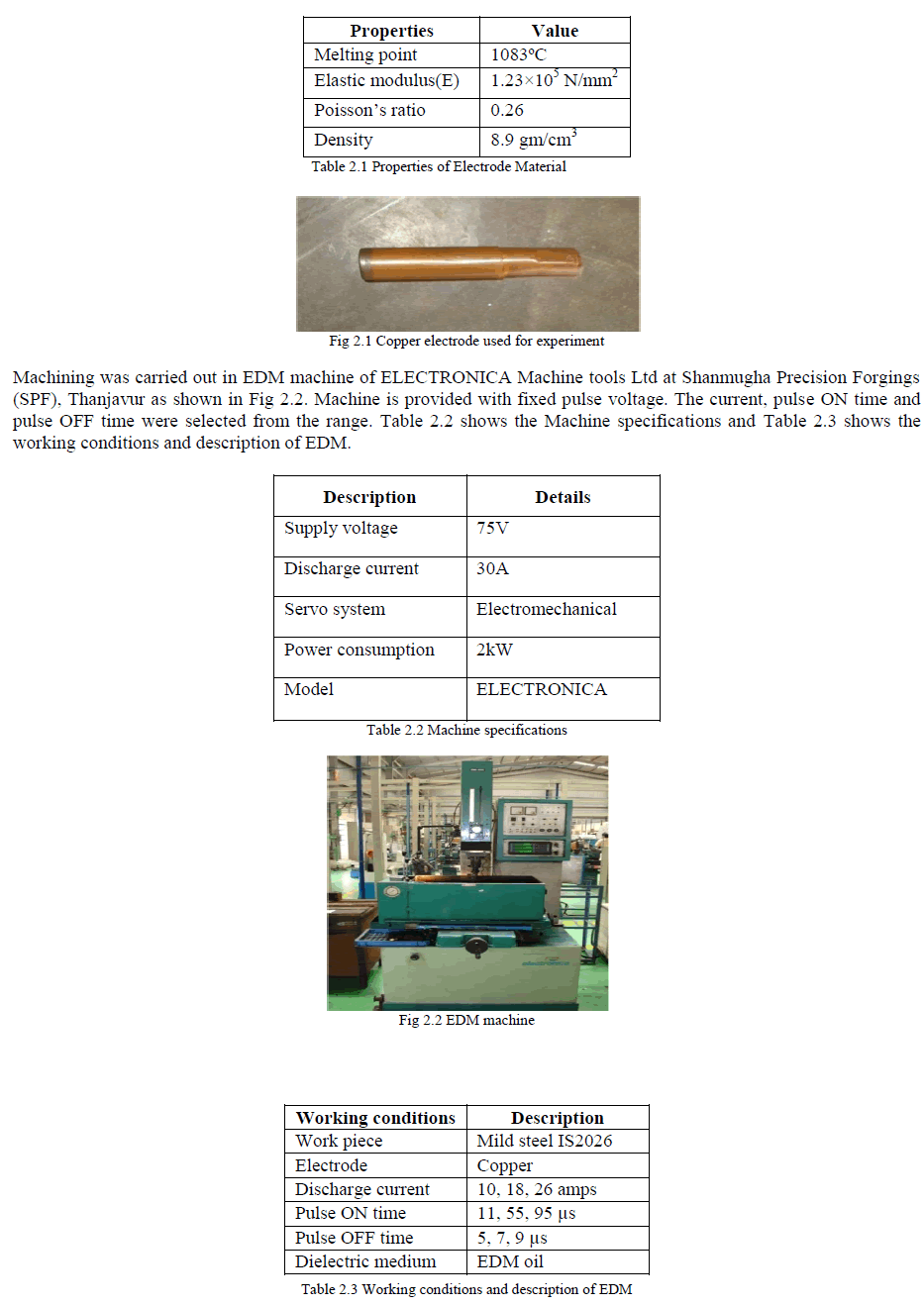 |
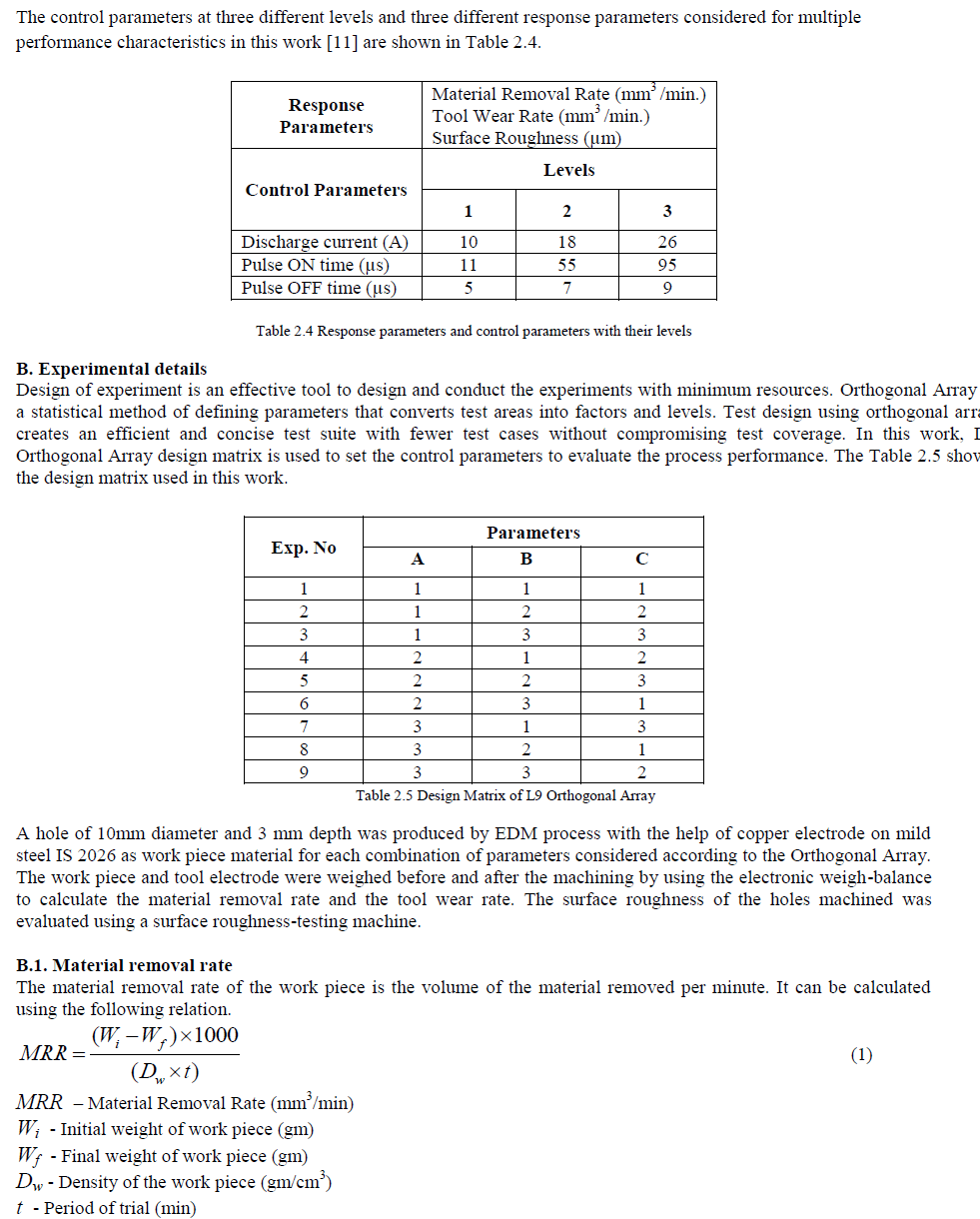 |
 |
B.3 Surface roughness |
| Roughness is often a good predictor of the performance of a mechanical component, since irregularities in the surface may form nucleation sites for cracks or corrosion [12]. Roughness is a measure of the texture of a surface. It is quantified by the vertical deviations of a real surface from its ideal form. If these deviations are large, the surface is rough; if small, the surface is smooth. Roughness is typically considered to be the high frequency, short wavelength component of a measured surface. The parameter mostly used for general surface roughness is Ra. It measures average roughness by comparing all the peaks and valleys to the mean line, and then averaging them all over the entire cut-off length. The surface roughness can be measured using a surface roughness tester machine, which is shown in Fig.2.3. |
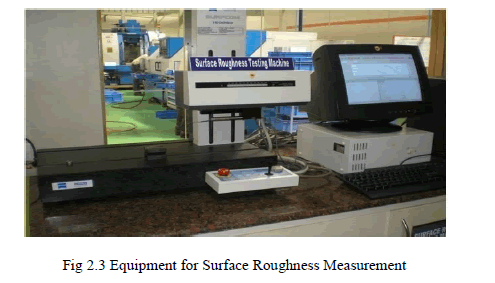 |
III. ANALYSIS OF EXPERIMENTS |
| The experiments were conducted based on varying the process parameters, which affect the machining process to obtain the required quality characteristics. Quality characteristics are the response values or output values expected out of the experiments. There are 64 such quality characteristics. The most commonly used are: 1) Larger the better 2) Smaller the better 3) Nominal the best 4) Classified attribute 5) Signed target As the objective is to obtain the high material removal rate (MRR), low tool wear rate, and best surface finish, it is concerned with obtaining larger value for MRR, smaller value of tool wear rate and smaller value of surface roughness. Hence, the required quality characteristic for high MRR is larger the better, which states that the output must be as large as possible, and for tool wear rate and surface roughness is smaller the better, which states that the output must be as low as possible. |
A. Experimental Results |
| Experiments were conducted as per L9 orthogonal array, assigning various values of the levels to the process parameters. After individual experiments for each set of values were conducted on mild steel IS 2026 for Ø10 mm and 3 mm depth of holes, Material removal rate and Tool wear rate are calculated using the equations (1) and (2). The surface roughness values were measured using surface roughness tester and the final results are given in the Table 3.1 |
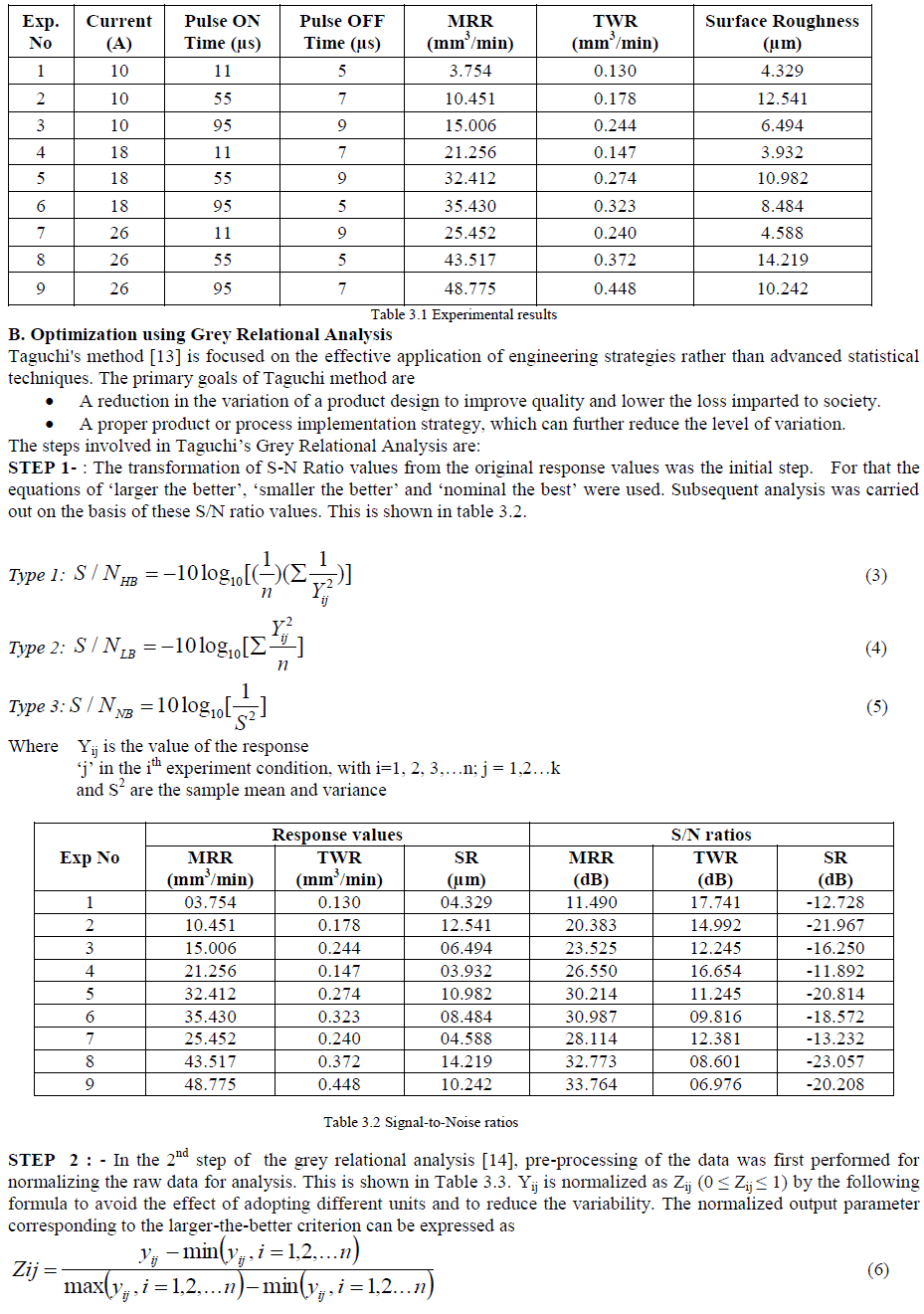 |
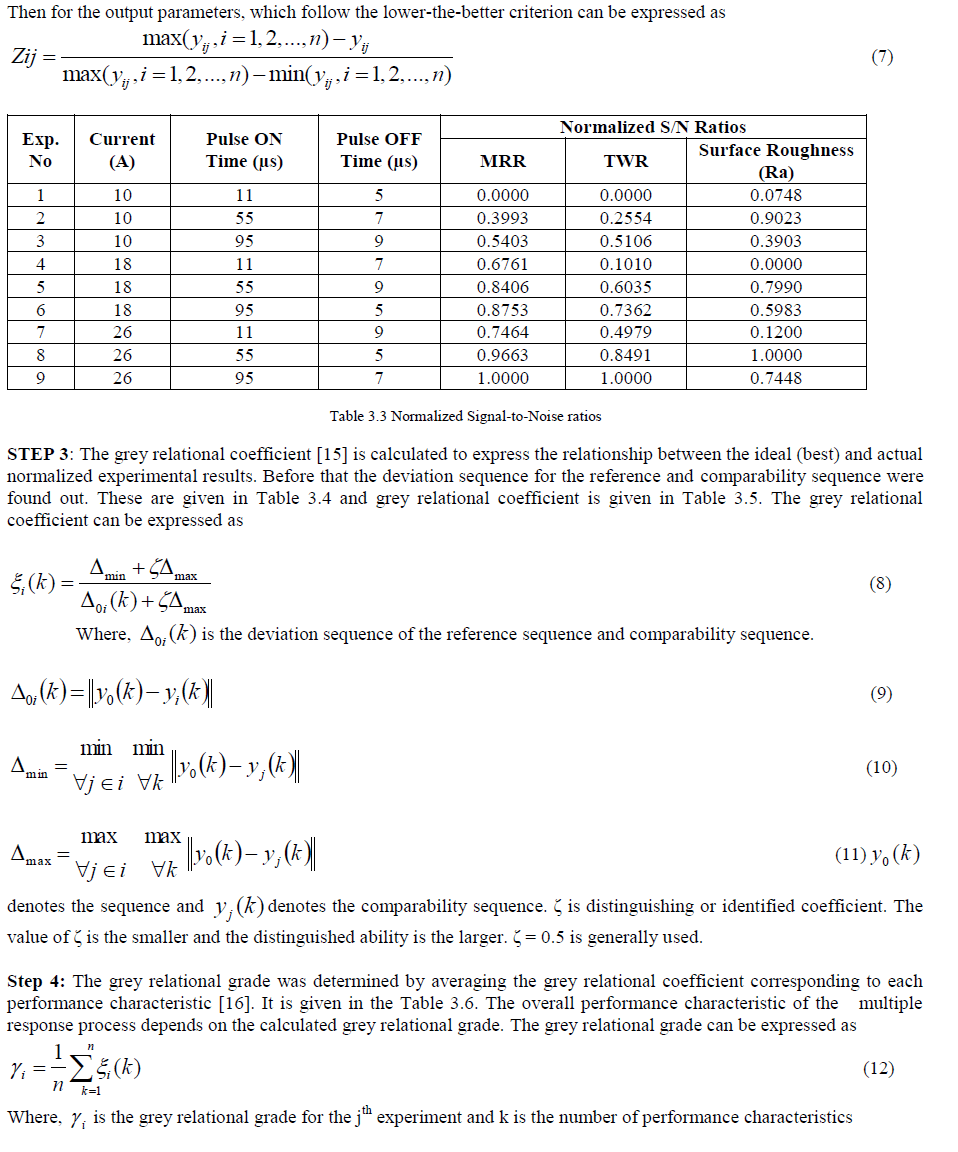 |
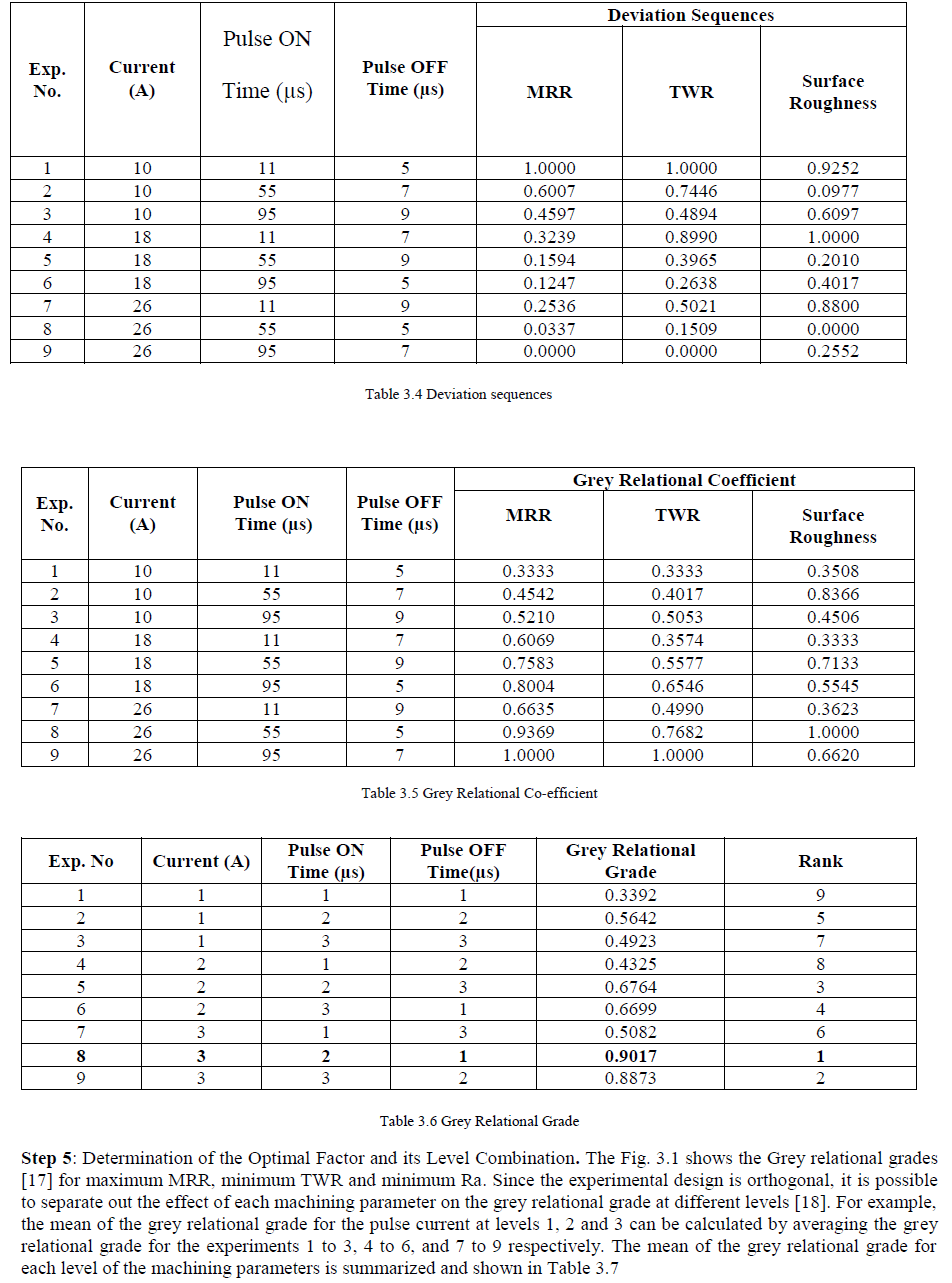 |
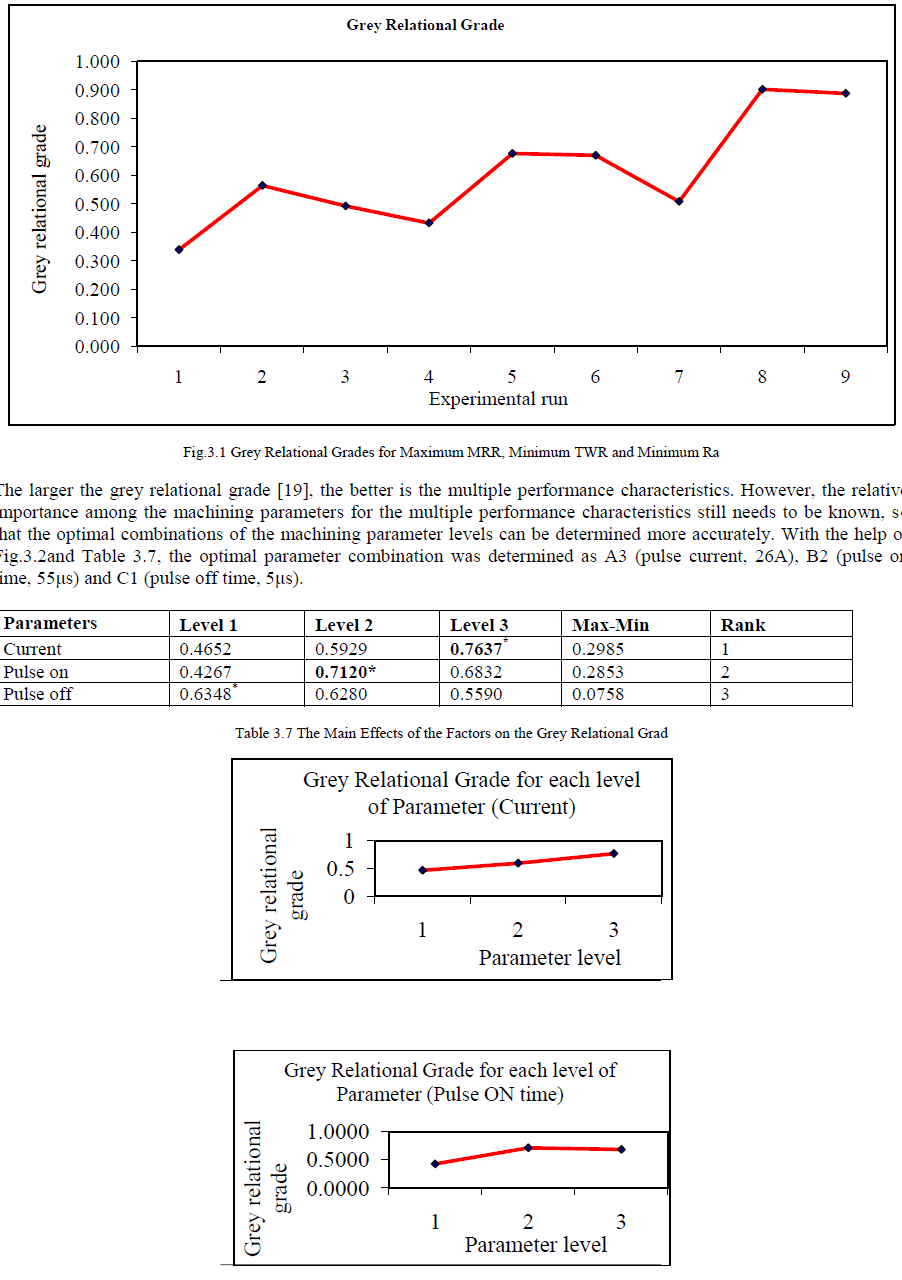 |
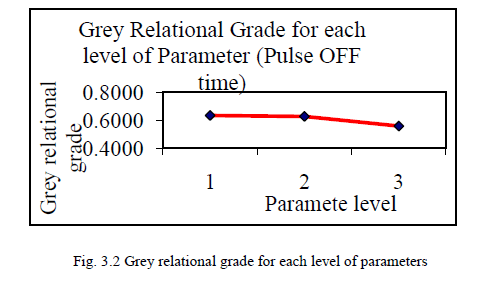 |
C. Confirming Results |
| The confirmation test for the optimal parameters with its levels were conducted to evaluate quality characteristics for EDM of mild steel IS 2026. Table 3.6 shows highest grey relational grade, indicating the initial process parameter set of A3B2C1 for the best multiple performance characteristics among the nine experiments. Table 3.8 shows the comparison of the experimental results for the optimal conditions (A3B2C1) with predicted results for optimal (A3B2C1) EDM parameters. The predicted values were obtained by |
Predicted Response = Average of A3 + Average of B2 + Average of C1 – 2 x Mean of response (Yij) |
| The response values obtained from the experiments are MRR = 43.517 mm³/min, TWR = 0.372mm³/min and the surface roughness is 14.219μm. The comparison again shows the good agreement between the predicted and the experimental values. |
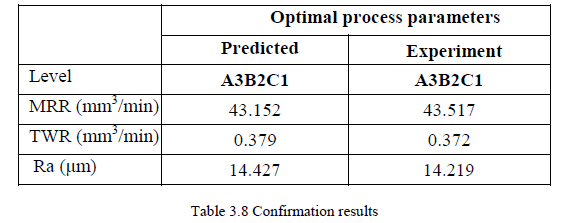 |
IV. CONCLUSIONS |
| TaguchiâÃâ¬ÃŸs Signal – to – Noise ratio and Grey Relational Analysis were applied in this work to improve the multi-response characteristics such as MRR (Material Removal Rate), TWR (Tool Wear Rate) and Surface Roughness of mild steel IS 2026 during EDM process. The conclusions of this work are summarized as follows: ïÃâ÷ The optimal parameters combination was determined as A3B2C1 i.e. pulse current at 26A, pulse ON time at 55μs and pulse OFF time at 5μs. ïÃâ÷ The predicted results were checked with experimental results and a good agreement was found. ïÃâ÷ This work demonstrates the method of using Taguchi methods for optimizing the EDM parameters for multiple response characteristics. |
ACKNOWLEDGEMENTS |
| The authors with gratitude thank the Vice-Chancellor, SASTRA University for permitting us to pursue the work at Shanmugha Precision Forgings (SPF), Thanjavur, Tamil Nadu, India. |
References |
|